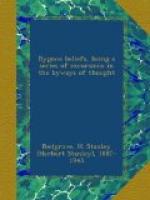As may be easily understood, many of the alchemists led most romantic lives, often running the risk of torture and death at the hands of avaricious princes who believed them to be in possession of the Philosopher’s Stone, and adopted such pleasant methods of extorting (or, at least, of trying to extort) their secrets. A brief sketch, which I quote from my Alchemy: Ancient and Modern (1911), SE 54, of the lives of ALEXANDER SETHON and MICHAEL SENDIVOGIUS, will serve as an example:—
“The date and birthplace of ALEXANDER SETHON, a Scottish alchemist, do not appear to have been recorded, but MICHAEL SENDIVOGIUS was probably born in Moravia about 1566. Sethon, we are told, was in possession of the arch-secrets of Alchemy. He visited Holland in 1602, proceeded after a time to Italy, and passed through Basle to Germany; meanwhile he is said to have performed many transmutations. Ultimately arriving at Dresden, however, he fell into the clutches of the young Elector, Christian II., who, in order to extort his secret, cast him into prison and put him to the torture, but without avail. Now it so happened that Sendivogius, who was in quest of the Philosopher’s Stone, was staying at Dresden, and hearing of Sethon’s imprisonment obtained permission to visit him. Sendivogius offered to effect Sethon’s escape in return for assistance in his alchemistic pursuits, to which arrangement the Scottish alchemist willingly agreed. After some considerable outlay of money in bribery, Sendivogius’s plan of escape was successfully carried out, and Sethon found himself a free man; but he refused to betray the high secrets of Hermetic philosophy to his rescuer. However, before his death, which occurred shortly afterwards, he presented him with an ounce of the transmutative powder. Sendivogius soon used up this powder, we are told, in effecting transmutations and cures, and, being fond of expensive living, he married Sethon’s widow, in the hope that she was in the possession of the transmutative secret. In this, however, he was disappointed; she knew nothing of the matter, but she had the manuscript of an alchemistic work written by her late husband. Shortly afterwards Sendivogius printed at Prague a book entitled The New Chemical Light under the name of `Cosmopolita,’ which is said to have been this work of Sethon’s, but which Sendivogius claimed for his own by the insertion of his name on the title page, in the form of an anagram. The tract On Sulphur which was printed at the end of the book in later editions, however, is said to have been the genuine work of the Moravian. Whilst his powder lasted, Sendivogius travelled about, performing, we are told, many transmutations. He was twice imprisoned in order to extort the secrets of alchemy from him, on one occasion escaping, and on the other occasion obtaining his release from the Emperor Rudolph. Afterwards, he appears to have degenerated into an impostor, but this is said to have been a finesse to hide his true character as an alchemistic adept. He died in 1646.”




